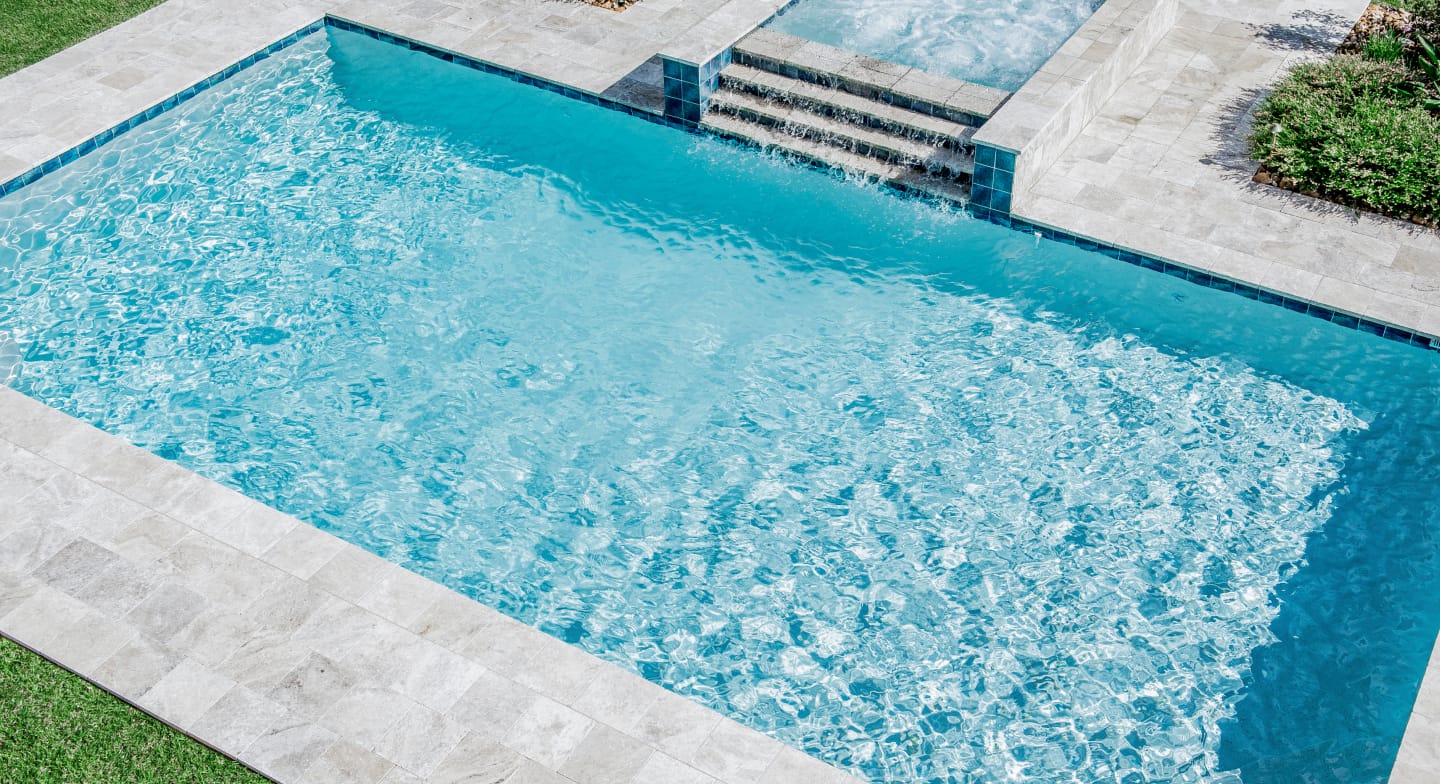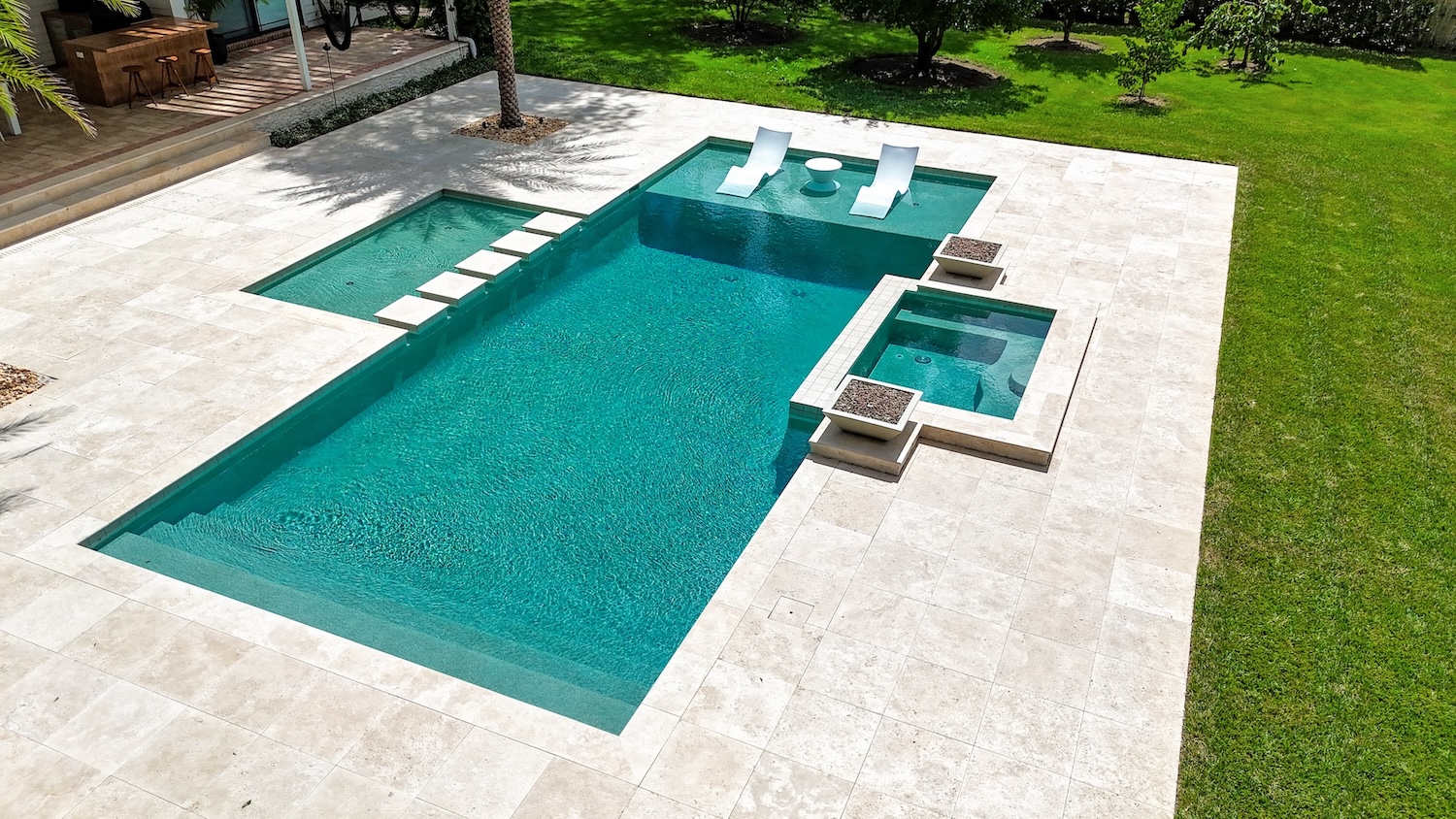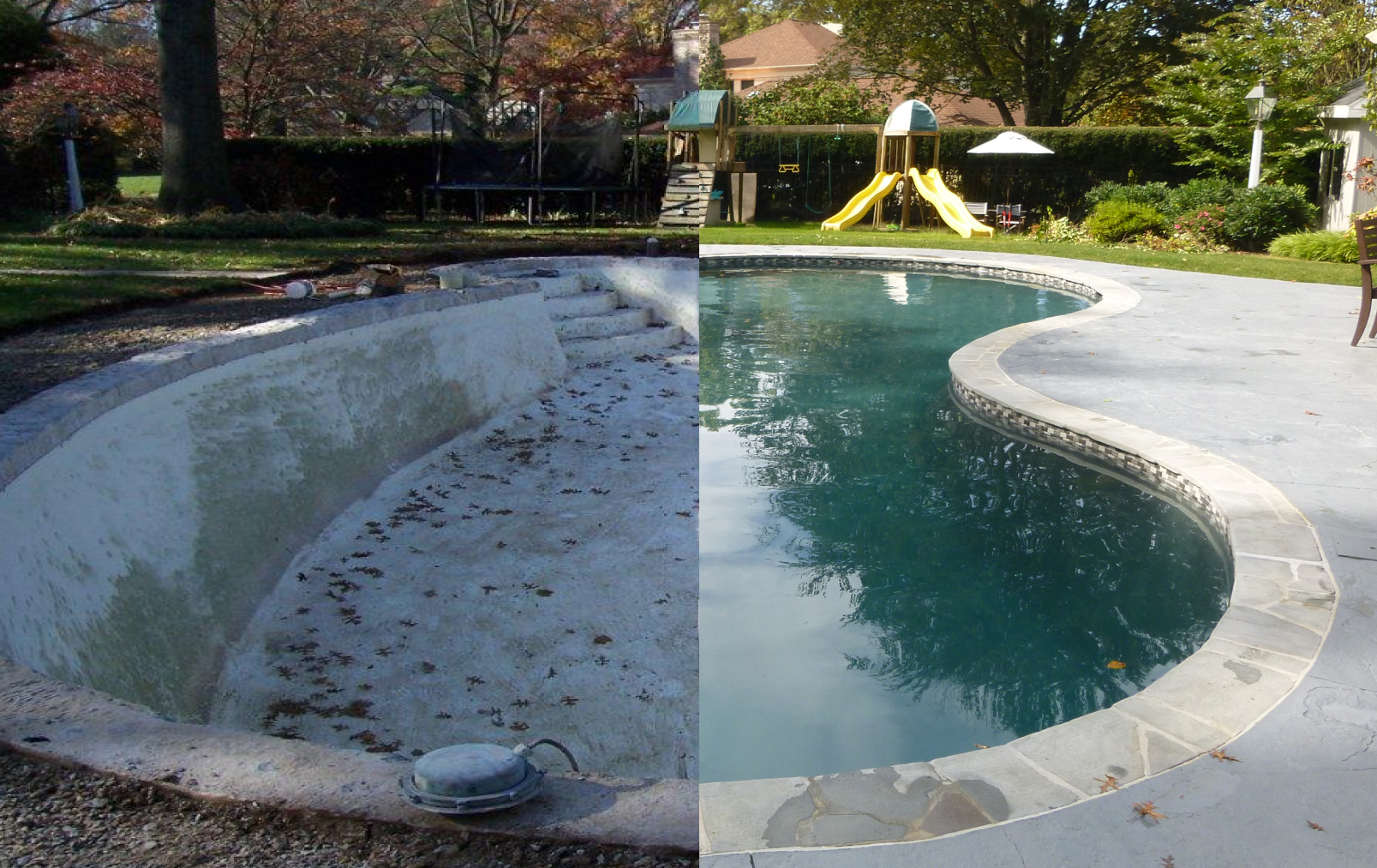When the weather heats up, nothing beats a relaxing soak in a swimming pool. But when you’re dreaming of diving into your own personal oasis of shimmering blue water, one question is bound to arise: How long does it take to build a pool?
The short answer? While most sources claim that it takes 8-12 weeks to build a new pool, a more realistic average pool installation is between 8-16 weeks. Your pool build timeline will depend on a number of factors, including the type of pool you want, the condition of your backyard, your local weather, and even the efficiency of your local government.
Since constructing a pool is a complicated endeavor, working with a reputable builder is key. A quality pool builder will be honest with you about your project’s timeline and costs and will help you navigate the tricky parts of the process, like choosing the perfect design and obtaining the necessary permits.
This guide will provide you with realistic expectations for your pool project and help you anticipate—and avoid—potential delays. Before you know it, you’ll be relaxing in your backyard oasis, wondering how you ever lived without your pool.
New Pool Construction Timeline Estimates
- Fastest Possible: If your construction project goes exactly as planned with no delays, you can expect it to take 8-10 weeks.
- More Common: Since pool construction is a complicated process, 12-16 weeks might be a more realistic estimate for your build. This timeline factors in a few delays.
- Unforeseen Challenges: What if your build has unforeseen challenges? If your pool build is plagued by red tape, bad weather, supply chain issues, and other construction woes, your timeline may extend to 5+ months. Working with a pool building professional should mitigate these risks significantly.
Your Realistic, Expert-Informed Timeline of How Long It Takes to Install an Inground Pool
To help you know what to expect, we’ve created a timeline of the milestones throughout the average pool installation.
Week 1-4: Pre-Construction (Permits, Approvals, and Site Prep)
Design & Permitting (2-4 weeks, sometimes longer)
The first step of new pool construction is choosing your pool’s design and features. Home design magazines and Instagram are great sources for inspiration. An expert Anthony & Sylvan pool designer will take careful note of your preferences and bring your vision to life in a 3D model. This collaborative design process typically takes 1-2 weeks.
When you begin designing your pool, it’s time to apply for a building permit. If you are part of an HOA, you may also need to obtain approval for your project from the board. A good pool builder will help you navigate the permitting process, which typically takes 2-4 weeks.
|
Utility Marking & Site Prep (2-5 days)
Before excavation can begin, your pool site must be clear of impediments like trees and large rocks. A vetted professional will use a utility locator to mark gas, water, and electrical lines that run through the area.
Week 5-6: Excavation & Framing
Excavation (3-5 days)
Excavation, or digging a hole for your pool, can take just 1-3 days if the ground in your backyard is easy to work with.
- Hidden delays and how to avoid them: Learning about the soil and topography of your backyard in advance may help you budget for excavation delays. For example, if your backyard has clayey or rocky soil or groundwater issues, the excavation process could take longer. If you live in a cold climate, excavators may have a hard time breaking ground in the winter. Constructing your pool during a milder time of year could speed excavation up.
Steel/Rebar Framing & Plumbing (5-10 days)
After excavation, your pool builder will install steel reinforcements to shape the pool. Think of framing as your pool’s sturdy skeleton. At this time, a pool plumber will also install your pool’s basic plumbing, including drains, return lines, and jets.
- Hidden delays and how to avoid them: You may need to have your pool’s plumbing inspected before the contractor can move on to shell installation. If so, work with your pool builder to set up a plumbing inspection early. Pool plumbing may take longer than average if you are installing complex water features like a fountain, a waterfall, or a hot tub.
Week 7-8: Shell Installation / Concrete Curing
The shell installation process depends on the type of pool you are building. Fiberglass pools are pre-manufactured and can be installed in just 1-2 days, though a crane may be required to fit your new pool into place. After that, backfilling and plumbing could take up to a week.
Gunite pools are fully customizable, so they are installed on-site. To form the shell of your concrete pool, your builder will spray gunite directly over the pool’s frame. This process will only take a day or two, but the concrete must then cure for an average of 7-10 days before work can continue.
- Hidden delays and how to avoid them: If you are installing a gunite pool, keep in mind that the curing process cannot be rushed. Planning to construct your pool at a mild time of year when weather is less likely to slow down the process should help keep the process on track.
Week 9-10: Tile, Coping, and Decking
Tile & Coping (1-2 weeks)
Once your pool’s shell is installed, it’s time to focus on the details, like tiling and coping. Tile goes around the inside edge of your pool, while coping hangs over its outside edge. Both provide your pool with added protection and aesthetic interest.
- Hidden delays and how to avoid them: When you choose your pool’s tile and coping during the design process, a pool building professional at Anthony & Sylvan will confirm that those materials are readily available. Choose materials that are easy for your builder to source. Weather can also be an issue when it comes to tiling, since the drying time of mortar used to affix tiles and coping in place is affected by extreme temperatures and moisture.
Decking & Hardscape (1-2 weeks)
Adding a pool deck or patio provides your backyard and area around your pool with visual appeal. Poured-concrete decks are the most cost-effective option on the market, but stone, wood, and PVC are other options to consider during the design process.
Due to state and local safety regulations, you may also need to add fencing around your pool—this is typically done during this point in the process.
- Hidden delays and how to avoid them: If you’re planning to construct an especially large or elaborate patio, this phase of pool construction may extend into additional weeks. This is especially likely if you are installing custom features like an outdoor kitchen or a sauna.
Week 11: Equipment & Final Touches
Equipment Installation & Electrical (3-5 days)
When the pool is structurally complete, it’s time to install its electrical components, like pumps, filters, heaters, and lights. A vetted pool electrician will ensure that all of your pool equipment is installed safely and functioning properly before allowing construction to continue.
- Hidden delays and how to avoid them: Because poorly wired pools present a significant safety hazard, you will need to have your pool’s electrical work and bonding inspected before your project is complete.
Plaster, Interior Finish, and Water Balancing (1-2 weeks)
Adding a plaster or pebble finish to your gunite pool typically takes just 1-2 days, but the curing process then requires your pool builder to immediately fill the pool and balance the water’s chemistry, which will take about 5-7 days. Fiberglass pools may require minor surface finishing before they, too, can be filled.
- Hidden delays and how to avoid them: If you aren’t in the pool business, you may be underestimating just how much water is required to fill a swimming pool! Pools can take about two days to fill, on average. Be sure to factor this time into your estimate.
Week 12+: Startup & Final Inspections
Some municipalities require a final inspection before your pool can be used. Even if a final inspection isn’t required, you might consider scheduling one. Ensuring that your pool is safe and well-constructed from the beginning can save you time and money in the long run.
- Hidden delays and how to avoid them: If your inspector finds an issue with your pool, you will need to perform the necessary repairs and then schedule and pass a second inspection. The best way to avoid this scenario is to work with a professional pool builder like those at Anthony & Sylvan who is well-acquainted with local regulations and known for doing great work.
Summary of Factors that Influence How Long it Takes to Build an Inground Pool
Permit delays
While some cities approve building permits within ten business days, other municipalities can take months to process your request. An experienced pool builder like Anthony & Sylvan can handle the permitting process for you, saving you time and stress.
Weather issues
Since new pool construction typically takes several months, it’s likely that bad weather will interrupt the process at some point. Extreme temperatures and precipitation can delay excavation, concrete curing, tiling, and plastering. Anthony & Sylvan will help you schedule your build to take advantage of blue skies.
Scheduling
If the right workers aren’t available, a phase of pool construction that should take a week can stretch into a month of frustration. Anthony & Sylvan schedules and coordinates with the best craftspeople in the business to keep your pool-building process moving in a timely manner.
Material shortages
Equipment or materials shortages may occur during your build, especially if you plan to build in the spring or summer. March-August is a pool contractor’s busiest season, so parts tend to be in especially short supply then. Anthony & Sylvan will keep you notified of supply shortages and help you navigate your options should you encounter one.
HOA/inspections
If you live in a community with a homeowner’s association, you may need to obtain permission from the HOA board at the same time that you obtain a building permit.
Inspections may be necessary at several points throughout the construction project. You may also need to get a full inspection when construction is complete. An experienced contractor like Anthony & Sylvan will be familiar with the inspection process and can help you prepare for it.
How Can I Reduce the Time It Takes to Build a Pool?
All good things take time, and your pool is no exception. However, there are several smart strategies you should know for saving time on pool construction. In fact, using several of these techniques could shave 4-8 weeks off of your timeline!
|
Pool Building Time Saver |
Potential Time Saved |
|
Cut out long permit delays |
2-4 weeks |
|
Build in the off-season |
1-3 weeks |
|
Avoid design changes |
1-2 weeks |
|
Pre-order materials |
2+ weeks |
- Work with a Well-Coordinated Pool Builder: Many contractors overbook jobs, which can lead to long gaps between construction phases. Choose a pool builder with a reputation for staying on schedule.
- When Possible, Get Permits and Approvals Early: Your city or county could take weeks or months to approve your building permit. To avoid delays, start the permitting process as early as possible. Bonus Tip: If your community has an HOA, request their approval at the same time that you submit your permit application to avoid double delays.
- Choose a Simpler Design: Choosing a standard pool shape and limiting custom features that require additional engineering, manpower and time can shrink your construction timeline.
- Build in the Fall: Pool builders are busiest in the warmer half of the year, making construction costs higher and materials harder to come by then. On the other hand, extreme winter cold can delay curing and plastering. Beginning construction in early fall gives you the best chance for lower costs and mild weather.
- Pre-Order Materials: Your pool builder should help you select the materials you’ll need for your pool in advance and confirm that they are available before construction begins.
- Use a Faster Decking Option: Some decking materials are more straightforward to install than others. Pressure-treated wood is inexpensive, widely available, and easy to work with, while durable composite decking that offers a hidden fastener option can speed installation by eliminating the need for exterior nails or screws.
- Be Available for Inspections and Approvals: When a visit from an inspector, HOA official or contractor is necessary, schedule it when you can be on-site. A short scheduling delay can snowball if builders have to wait for approval to continue work.
- Avoid Change Orders:If you change your mind about your pool’s design after building begins, you risk huge delays and unexpected expenses. Sticking to your original construction plan will keep the project running smoothly.
If your pool absolutely must be completed by a specific date, you may be able to request a compressed schedule for your pool build. Companies that complete building tasks sequentially—one at a time—may not be able to help. However, some builders are open to overlapping building phases whenever possible to save you time.
Your Pool-Building FAQs Answered
1. What is the biggest factor that causes pool construction delays?
The top two factors that can delay your pool construction project are permit approval and extreme weather. Though it may be impossible to predict the weather or completely eliminate red tape, factoring in time for both can save you frustration.
2. Can I build a pool faster by hiring multiple contractors?
No, hiring multiple contractors does not expedite the pool construction process. Most pool builders, including Anthony & Sylvan maintain long-standing relationships with trusted craftspeople. This practice ensures that different types of work are done by the appropriate specialists—and therefore performed at the highest caliber. Hiring your own team of professionals can lead to miscommunications that slow the build down.
3. When is the best time of year to build a pool?
Because most people begin pool construction projects in the spring and summer, labor tends to be more expensive and materials are in shorter supply from March to August. Thus, the best time to begin a pool construction project is in the fall.
4. Will installing a fiberglass pool help me save time?
Probably not to the extent you’re thinking. When comparing gunite vs. fiberglass pools, many companies state that the installation of fiberglass pools is a big time-saver, when really it will likely only speed up your pool construction project by 1-2 weeks. Meanwhile, gunite pools are known for their durability and can last for decades with proper upkeep. Anthony & Sylvan offers a Lifetime Structural Warranty for their gunite pools!
5. How long does it take for a gunite pool to cure?
Once gunite has been sprayed over your pool’s shell, work must stop for 7-10 days as the material cures, or hardens. If extreme temperatures or excessive rain occur during curing, it might slow the process down. In all, it may take up to four weeks for your pool’s concrete to adequately cure.
6. What is the fastest way to get permits approved?
To get permits approved quickly, begin the process early, submit all the required documents at once, and work with a builder who understands local permit requirements. If you have an HOA, securing their approval around the same time that you submit your city permit application can prevent further delays. A professional pool building company will handle this part of the process for you.
7. Can I use my pool as soon as construction is done?
You will want to avoid swimming until your pool’s pump, filter, and heater have been installed and your pool has been thoroughly inspected. Additionally, you shouldn’t use your pool for at least 24 hours after the water has been treated to ensure that its chemistry has had time to balance. But it’s all worth the wait!
8. What happens if bad weather hits during construction?
Any type of extreme weather will naturally cause delays in pool construction. The scale of the disruption depends on which phase of construction your pool builder is on when bad weather strikes. For instance, extreme cold could derail excavation, while excessive rain could extend the gunite curing process.
A smart builder will give you a timeline for your project that builds in a buffer for disruptions, especially if you are constructing your pool at a time of year that is known for rough weather in your area.
9. How do I make sure my pool project stays on schedule?
Some delays are impossible to avoid during a long-term outdoor construction project. However, there are a few simple things you can do to minimize disruptions.
- Confirm your design choices up-front to avoid mid-project changes.
- Choose your materials early and ensure they are available before construction begins.
- Be available for all inspections and approvals to prevent unnecessary waiting.
- Work with a builder who has a reputation for on-time work and good subcontractor coordination.
10. What’s the best way to avoid unexpected costs during construction?
Unexpected costs often accompany unexpected mid-project design changes. Sticking to your original design throughout the construction process will increase the likelihood that your project’s price will match or approximate your initial estimate.
Anthony & Sylvan Can Have You Swimming Sooner
Anthony & Sylvan is America’s most trusted pool builder for a reason: we respect your time. From financing to permitting, excavation to shell installation, and lighting to patio construction, our experts are committed to making the pool construction process as simple, fast, and efficient as possible.
If you’re ready to take the plunge, request a free on-site design consultation from Anthony & Sylvan, including a custom 3D rendering of your dream pool.




